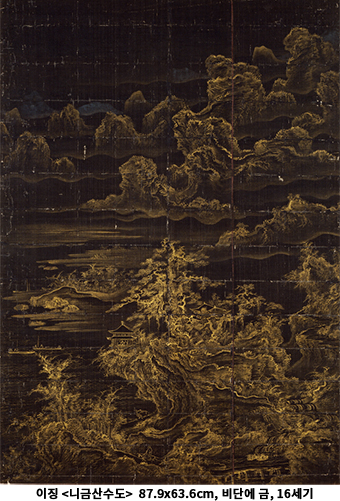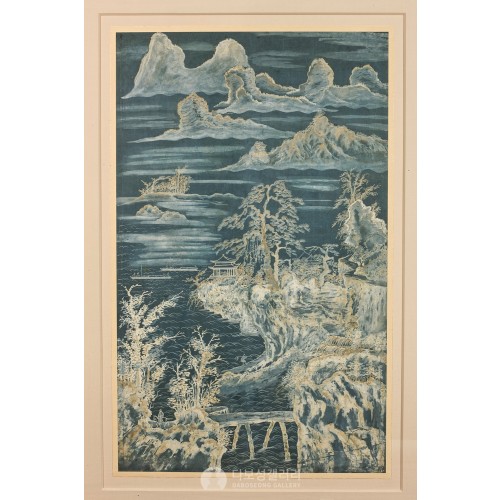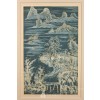본문
16세기 조선 중기 유명한 화가인 허주(虛舟) 이징(李澄, 1581~?)이 감지(紺紙)에 흰색과 금색으로 그린 니금산수화입니다.
감지는 한지에 쪽물을 들여 만든 것으로, 금분으로 경전을 쓸 때 사대부가 즐겨 사용하던 고급 종이였습니다.
이징은 감지 위에 금과 진흙을 개어 만든 안료로 안개가 자욱한 아름다운 산수를 안견의 <몽유도원도>(1447)처럼 절파화풍으로 그렸습니다.
앞쪽에는 나무로 만든 다리가 있고, 그 뒤의 강변에서 한 선비가 어깨 위에 물고기가 걸린 낚싯대를 얹어 언덕 위로 올라가고 있습니다.
안빈낙도하는 선비의 모습 그대로입니다. 이 선비 너머의 강변에는 선비의 행선지로 보이는 기와 정자 두 채가 서 있습니다. 추운 겨울에도 푸른 생명력을 잃지 않는 소나무와 바위 사이에 나란히 들어서 있어서 선비의 굳은 절개를 보는 듯합니다. 그 앞의 강물 위에는 작은 크기의 인물이 타고 있는 두 척의 배가 떠 있고, 그 너머로 산과 하늘이 보입니다. 정교한 필치와 뛰어난 기교가 조선의 니금산수화 면모를 보여주는 걸작입니다.
이 그림의 우측 하단을 살펴보면 접힌 듯한 자국이 있는 것을 확인할 수 있는데, 이는 이 그림이 책갈피 속에서 접힌 채로 보관되어 있었기 때문입니다.
접힌 자국조차도 그림의 한 부분처럼 남아있어 더욱 가치 있는 유물이라고 생각됩니다.
이와 비슷한 그림으로 용산 국립중앙박물관에 소장된 같은 이름의 회화가 있습니다.

━━━━━
这是16世纪朝鲜中期的著名画家虚舟李澄( 1581~卒年不详)在绀纸上用白色和金色所画泥金山水画。绀纸是在韩国纸上用靛蓝染料制成。是贵族用金粉写经时喜欢使用的高级纸。
李澄用金泥混合颜料在韩纸上用金和泥土叠成的颜料画了一幅美丽的雾景,就像安坚的《梦游桃园图》(1447 年)一样。前面有一座木桥,后面有个江边书生,肩上扛着鱼竿,正在往山上爬。这就是安贫乐道的书生形象。
在这位儒生另一侧的江边,有两座看是书生行善的瓦片亭子并排耸立在寒冷的冬天也不失绿色生命力的松树和岩石之间。前面的江面上漂浮着两艘小人物乘坐的船,从那边可以看到山和天空。精湛的笔触和精湛的技巧是展现朝鲜时期泥金山画面貌的杰作。
观察这幅画的右下角,可以确认有折叠的痕迹,因为这幅画是在书签中折叠保管的。 就连折痕也像画的一部分一样残存下来,因此我认为是更有价值的文物。国立中央博物馆有收藏与此类似的同名作品。
━━━━━
a landscape painted in white and gold on gold paper. Similar to this, Lee Cheng-shan water paintings are in the collection of the National Museum of Korea.The background of the painting is an infected bird loved by the teacher, who painted beautiful landscapes with a mixture of gold and clay. The style is a picture depicting the dream of Ahn's great dream, "A Dream in the Peach Circle" painter Ahn Jian often uses, displaying harmony and balance of beauty. There was a wooden bridge ahead, and a bookseller on the river's side climbed up the hill with a fishing rod on his shoulder. This is the look of a Confucian scholar who is content to live in poverty. On the other side of the river, two tile-paved pines with green vitality stood side by side, looking at the scholar's good place. On the river ahead is a boat on which two little people ride, facing the mountains and the sky.Skillful strokes and excellent skill are masterpieces that show the landscape of the waters of Mt. Nijin of Joseon.Similar paintings include paintings of the same name collected by the National Museum of Korea.

